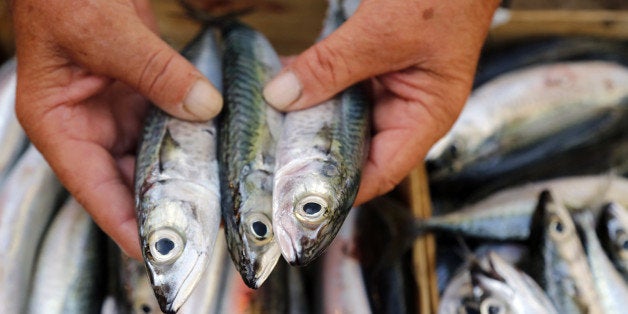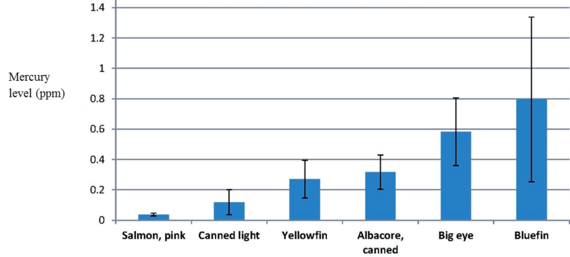
Co-authored by Elizabeth Brown
A few days ago, the Food and Drug Administration (FDA) and Environmental Protection Agency (EPA) released updated draft advice on fish consumption for childbearing aged women and young children.
The new advice encourages pregnant women, women who may become pregnant, breastfeeding women, and young children to consume 2-3 servings of a variety of fish per week (a total of 8-12 ounces per week for women and smaller portions for children) that are lower in mercury. This is the first time the agencies have recommended a minimum fish consumption level.
They say they want to encourage fish consumption because studies show that the nutritional value of fish is important during childhood development and development prior to birth -- for instance, eating fish may improve fetal brain development and raise children's IQs. Fish contain high-quality protein, many vitamins and minerals, and some have high amounts of omega-3 fatty acids.
But fish also contain mercury, and too much mercury is bad for humans, particularly for developing fetuses and children. It can cause brain and neurological damage1. So that is why choosing lower mercury fish is important.
Mercury in fish comes from coal; when coal is burned, mercury is released into the environment and it eventually enters our waterways, where it is absorbed by fish. When we eat fish we get a dose of mercury. Roxanne Karimi of Stony Brook's Consortium for Interdisciplinary Environmental Research says "Mercury is not to be taken lightly. It crosses the blood-brain barrier and it crosses the placenta. It leaves the body slowly."
However by choosing fish wisely, women and children can get the benefits of fish without the mercury risk. As a general rule, it is best to eat lower on the food chain. Mercury accumulates up the food chain, so large, predatory fish have higher mercury levels than smaller, lower on the food chain fish.
The updated fish consumption advice from the FDA and EPA provides several safer, lower mercury fish choices. Plus they provide a table that lists mercury and omega-3 levels in common fish species to help consumers make smart seafood choices. Lower mercury fish options that have high amounts of omega-3s include salmon, mussels, sardines, herring, anchovies, and trout. Other lower mercury choices include pollock, cod, shrimp, tilapia, catfish, and canned light tuna. The agencies are encouraging consumers to eat a variety of these lower mercury fish, rather than just one type.
Similar to the current advice, the agencies recommend that:
-- childbearing aged women and young children avoid certain species with very high mercury levels - king mackerel, swordfish, shark, and tilefish from the Gulf of Mexico.
--women consume no more than 6 ounces of albacore tuna a week.
--parents similarly limit how much albacore tuna their children consume, depending on their children's age.
The agencies are also considering adding marlin and orange roughy -- two other species high in mercury -- to the "avoid" list. They are seeking public comment on this.
The new draft advice is much better than the current advice and provides the public with much more information about the benefits vs. risks of eating fish. But it still has some problems.
The advice on tuna is not conservative enough. Experts say that if light or average weight (166 lb) women eat 6 ounces of albacore tuna a week as recommended by the FDA and EPA, they will exceed safe mercury levels2. As well, the advice does not give a clear picture of mercury levels in tuna, or provide any warnings about eating dark tuna -- like bigeye and bluefin, which have even higher mercury levels than albacore. Tuna is the second most popular seafood item after shrimp and tuna consumption accounts for one third of Americans mercury exposure, so accurate advice is essential.

Comparison of mercury levels in salmon vs. different types of tuna.Graphic by Susan Silbernagel, Gelfond Fund for Mercury Research and Outreach.Data source: Karimi et al. 2012 "A Quantitative Synthesis of Mercury in Commercial Seafood and Implications for Exposure in the United States"
The agencies also don't provide any warnings about mercury for non-childbearing women and men who consume a lot of fish. While childbearing women and young children are the groups most at risk from mercury, anyone who consumes more than 2-3 servings of fish per week needs to pay attention to what types of fish they are consuming and how much mercury those fish have in order to avoid potential health risks.
Our partners with the Gelfond Fund for Mercury Research and Outreach at Stony Brook University recently measured blood mercury levels in Long Island, New York seafood consumers. They found that nearly half of the participants in their study had blood mercury levels above "safe levels"(5.8 micrograms per liter). Elevated blood mercury levels were associated with weekly consumption of tuna steaks, fillets, or sushi or monthly consumption of swordfish, marlin, or shark3.
The FDA and EPA need to ensure they are providing seafood consumers with the most accurate and complete information about mercury levels in fish. And they need to err on the side of caution. The agencies still have time to get the advice right. Hopefully they will.
The full FDA and EPA draft seafood advice is available here. They are seeking public comments on the draft advice, so we encourage you to tell the agencies what you think!
For more information on mercury in seafood check out The Safina Center's Mercury in Seafood Section or the Gelfond Fund for Mercury Research and Outreach. To find seafood options that are both sustainable and healthy, visit The Safina Center's online Seafood Choices Guide.
Notes:
